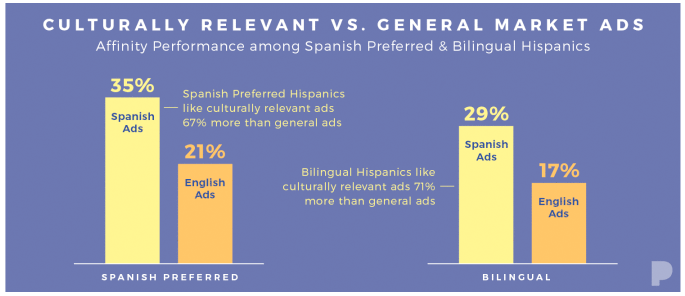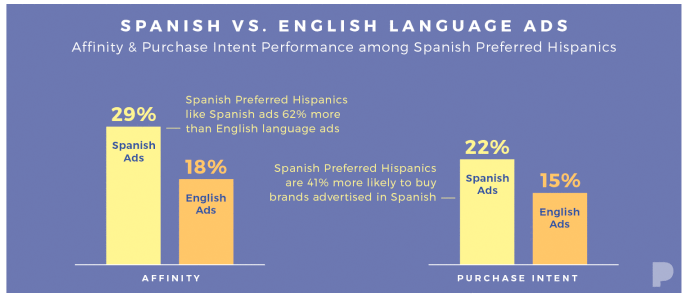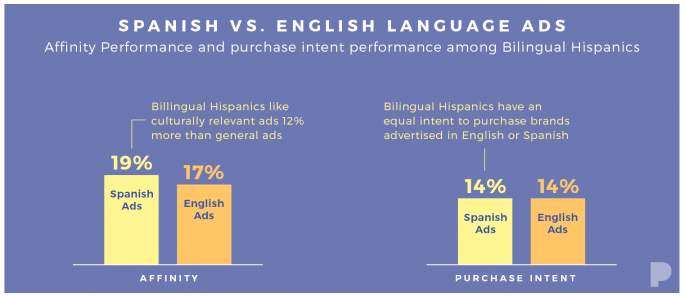Language Decoded: New Study Reveals the Best Way to Reach Hispanics
September 16, 2017

Today, 36% of U.S. Hispanic adults are bilingual. This includes 25% who mainly use English and 38% who mainly use Spanish. Even among those who primarily speak English, over half consider themselves bilingual.1
Yet still, many marketers are under the impression that all consumers can be reached with the same ad creative and message. They believe that incorporating cultural elements into their ad campaigns–including language–doesn’t fundamentally move the needle on how a brand is perceived in the market and among a multicultural audience.
But for Hispanic-Americans, who currently make up the largest minority group in the U.S., we need to realize that they embrace not just a blending of cultures, but also of languages as they toggle between Spanish and English throughout their day-to-day activities. In fact, it’s their dynamic use of language that compels marketers to constantly reassess one, time-worn question: “Should my brand advertise to Hispanics in Spanish or English?”
The correct answer to this question depends on several important factors, like demographics, location, industry and context. But whether a brand decides to use Spanish or English in their ads, it’s critical to keep in mind that there’s another universal way of reaching and resonating with this audience: culture.
Culture plays an important role in the lives of Hispanic consumers–something we’ve noticed first-hand at Pandora. In fact, we created our high-performing Hispanic targeting segments (“Spanish Preferred” and “Hispanic Bilingual”) by observing music listening habits. Based on the percentage of time a listener spends listening to Spanish music, we can make an accurate approximation of how much they prefer one language over another. This level of insight allows us to help our brand partners serve ads and experiences to Hispanic listeners that resonate with them on a deeper and more emotional level.
To date, campaign performance and anecdotal feedback has proven our targeting methodology. But to more accurately quantify the language preferences of Hispanic-Americans, we needed to test Spanish and English ad creative side-by-side.
Introducing…Language Decoded
In December 2016, Pandora conducted a robust user study of over 1,000 Hispanic Pandora listeners to determine whether ads served in Spanish or English were more effective at driving brand affinity and purchase intent. The selected listeners qualified if they’d used Pandora within the last three months, were at least 18-years-old at the time of registration, and exhibited listening behavior in the past month that aligned with our Spanish Preferred or Hispanic Bilingual audience segments.
During the study, participants were randomly presented with a Spanish or English version of an ad, with a total of three pairs of ads tested. Differences ranged from a direct language translation to ads with cultural cues or in-culture adaptations, which include the use of Hispanic music, voices, themes and images. The listeners were then asked a series of questions about how much they liked the ad and felt the message was relevant to them, along with their intent to purchase the advertised product.
According to Keri Degroot, Pandora’s Vice President of Research and Analytics at Pandora, “We hypothesized that Spanish ads, particularly those displaying strong cultural cues and nuances, would resonate better than general market versions of the same ad. We were eager to conduct this study and excited by what it told us about the power of language and culture in advertising.”
What We Learned
While we found that most Hispanic listeners exhibited a preference for Spanish ad creative, the impact of language on purchase intent depended on whether the listener was primarily a Spanish speaker, or not. The inclusion of cultural elements, however, seemed to have the biggest effect on how well the ad engaged and resonated with a Hispanic audience.
Lesson #1
Spanish Preferred and Hispanic Bilingual listeners show a higher affinity for ad creative featuring cultural cues.

Lesson #2
Spanish Preferred listeners like Spanish-language ads 62% more than English ads and are 41% more likely to buy from brands that advertise in Spanish.

Lesson #3
Bilingual listeners like Spanish-language ads 12% more than English-ads, but show equal intent to purchase between brands that advertise in Spanish and ones that advertise English.

Don’t Underestimate the Power of Culture
When it comes to advertising to Hispanic-Americans, language preference is a fluid subject and largely depends on whether the target audience prefers to speak Spanish or English in other areas of their lives.
But what this study undeniably proved was the profound impact that cultural elements have on the overall effectiveness of an ad. The study found that ads containing cultural cues or in-culture adaptations led to higher affinity scores among both Pandora’s Spanish Preferred and Hispanic Bilingual audience targeting segments.
For marketers looking to attract and engage Hispanic consumers, incorporating strong cultural cues is a proven way to increase relevancy among this influential audience. And combined with data-rich targeting capabilities, adding culturally-relevant elements to an ad can turn a mass market initiative into one that is personalized and relevant for the today’s largest multicultural segment.
Want to dive deeper into the language preferences of bilinguals? We unpack even more data from this study in a new Pandora for Brands Report titled, “Language Decoded: What Bilingual Audiences Expect in Advertising.” For many, this is the Hispanic segment that’s most difficult to pin down from a language perspective. Use this report to gain a clear understanding of what language is best to convey your brand message.
To download report CLICK HERE.






























